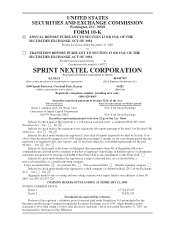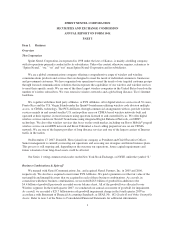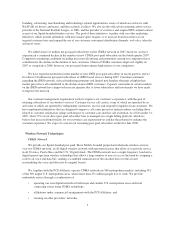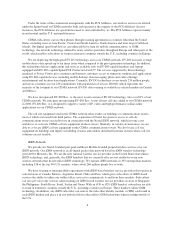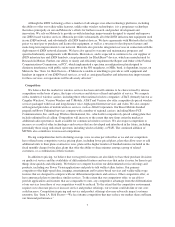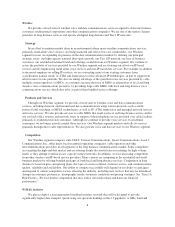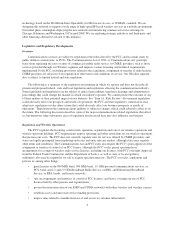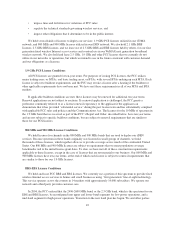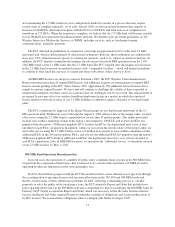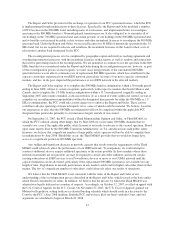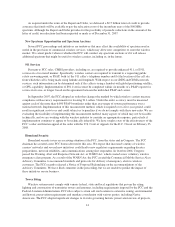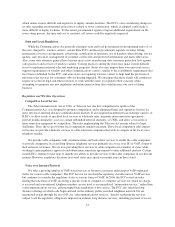Sprint - Nextel 2007 Annual Report Download - page 10
Download and view the complete annual report
Please find page 10 of the 2007 Sprint - Nextel annual report below. You can navigate through the pages in the report by either clicking on the pages listed below, or by using the keyword search tool below to find specific information within the annual report.Wireline
We provide a broad suite of wireline voice and data communications services targeted to domestic business
customers, multinational corporations and other communications companies. We are one of the nation’s largest
providers of long distance services and operate all-digital long distance and Tier 1 IP networks.
Strategy
In an effort to maintain market share in an environment where many wireline communications services,
primarily stand-alone voice services, are being marketed and sold as low-cost commodities, our Wireline
segment focuses on expanding its presence in the data communications markets by utilizing our principal
strategic assets: our high-capacity national fiber-optic network, our Tier 1 IP network, our base of business
customers, our established national brand and offerings available from our Wireless segment. We continue to
assess the portfolio of services provided by our Wireline segment and are focusing our efforts on IP-based
services and de-emphasizing stand-alone voice services and non-IP-based data services. For example, in addition
to increased emphasis on selling IP services, we are converting many of our existing customers from
asynchronous transfer mode, or ATM, and frame relay to more advanced IP technologies, in part to support our
effort to move to one platform. We also are taking advantage of the growth in voice services provided by cable
multiple system operators, or MSOs, as consumers increase their use of MSOs as alternatives to local and long
distance voice communications providers, by providing large cable MSOs with local and long distance voice
communications service, which they offer as part of their bundled service offerings.
Products and Services
Through our Wireline segment, we provide a broad suite of wireline voice and data communications
services, including domestic and international data communications using various protocols such as multi-
protocol label switching, or MPLS, technologies, as well as IP, ATM, frame relay and managed network services
and voice services. We also provide services to cable MSOs that resell our local and long distance service and/or
use our back office systems and network assets in support of their telephone service provided over cable facilities
primarily to residential end user customers. Although we continue to provide voice services to residential
consumers, we no longer actively market those services. Our Wireline segment markets and sells its services
primarily through direct sales representatives. We also provide voice and data services to our Wireless segment.
Competition
Our Wireline segment competes with AT&T, Verizon Communications, Qwest Communications, Level 3
Communications, Inc., other major local incumbent operating companies, cable operators and other
telecommunications providers in all segments of the long distance communications market. Some competitors
are targeting the high-end data market and are offering deeply discounted rates in exchange for high-volume
traffic as they attempt to utilize excess capacity in their networks. In addition, we face increasing competition
from other wireless and IP-based service providers. Many carriers are competing in the residential and small
business markets by offering bundled packages of both local and long distance services. Competition in long
distance is based on price and pricing plans, the types of services offered, customer service, and communications
quality, reliability and availability. Our ability to compete successfully will depend on our ability to anticipate
and respond to various competitive factors affecting the industry, including new services that may be introduced,
changes in consumer preferences, demographic trends, economic conditions and pricing strategies. See “Item 1A.
Risk Factors—We face intense competition that may reduce our market share and harm our financial
performance.”
WiMAX Initiative
We plan to deploy a next generation broadband wireless network that will be designed to provide
significantly higher data transport speeds using our spectrum holdings in the 2.5 gigahertz, or GHz, band and
8

